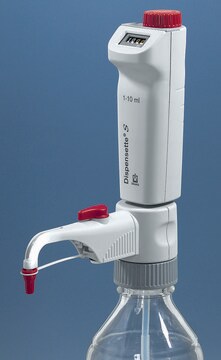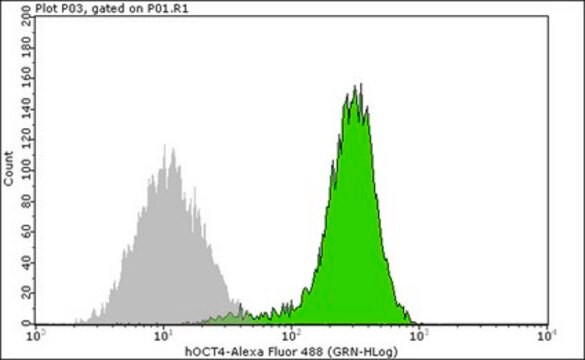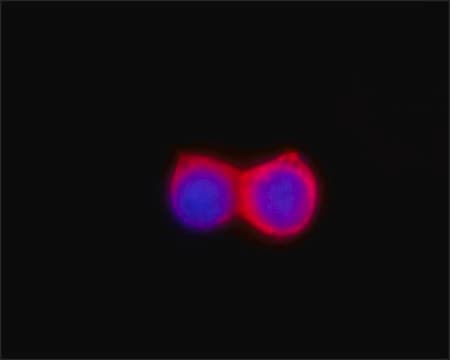일반 설명
We are committed to bringing you greener alternative products, which adhere to one or more of the 12 Principles of Green Chemistry. This antibody is preservative-free, produced without the harm or sacrifice of animals and exceptionally stable to allow for ambient shipping and storage if needed, and thus aligns with "Waste Prevention", "Designing Safer Chemicals" and "Design for Energy Efficiency".
Click here for more information.
ZooMAb® antibodies represent an entirely new generation of recombinant monoclonal antibodies. Each ZooMAb® antibody is manufactured using our proprietary recombinant expression system, purified to homogeneity, and precisely dispensed to produce robust and highly reproducible lot-to-lot consistency. Only top-performing clones are released for use by researchers. Each antibody is validated for high specificity and affinity across multiple applications, including its most commonly used application. ZooMAb® antibodies are reliably available and ready to ship when you need them.
특이성
Clone 1C18 is a ZooMAb® recombinant rabbit monoclonal antibody that specifically detects S1PR2. It targets an epitope within 25 amino acids from the N-terminal extracellular domain.
면역원
KLH-conjugated linear peptide corresponding to 25 amino acids from the N-terminal, extracellular domain of human S1PR2.
애플리케이션
Quality Control Testing
Evaluated by Western Blotting in membrane extract from human cerebral cortex.
Western Blotting Analysis (WB): A 1:1,000 dilution of this antibody detected S1PR2 in membrane extract from human cerebral cortex.
Tested Applications
Affinity Binding Assay: A representative lot of this antibody bound S1PR2 peptide with at least one hundred thousand-fold (100,000X) higher than with non-specific control peptide.
Immunohistochemistry (Paraffin) Analysis: A 1:100 dilution from a representative lot detected S1PR2 in human cerebral cortex tissue sections and human tonsil tissue sections.
Note: Actual optimal working dilutions must be determined by end user as specimens, and experimental conditions may vary with the end user.
표적 설명
Sphingosine 1-phosphate receptor 2 (UniProt: O95136; also known as S1P receptor 2, S1P2, Endothelial differentiation G-protein coupled receptor 5, Sphingosine 1-phosphate receptor Edg-5, S1P receptor Edg-5) is encoded by the S1PR2 (also known as EDG5) gene (Gene ID: 9294) in human. It is a ubiquitous G-protein coupled receptor for lysosphingolipid sphingosine 1-phosphate (S1P). S1P acts as an intercellular mediator by interacting with the endothelial differentiation gene (EDG)/S1P family of G protein-coupled receptors. It is coupled to Gi, G12/13, and Gq pathways to regulate a number of second messengers and effector molecules, including cAMP, PLC, MAPK, RhoA, and Rac. S1PR2 mediates the effects of S1P on cell motility and embryonic development, among other cellular processes. S1PR2 is widely expressed across various organs and cell types. It is prominently found in neuronal and vascular cells, macrophages, monocytes, and granulocytes. S1PR2 is a multi-pass membrane protein and primarily localized on the cell surface. S1P2 receptor is involved in S1P-induced platelet aggregation and Rho kinase activation. Activation of S1P2R in endothelial cells increases vascular permeability. It mediates immune cell trafficking, angiogenesis, and vascular function. S1PR2 activates downstream signaling pathways such as phosphoinositide 3-kinase (PI3K), Mitogen-activated protein kinase (MAPK), and Rho/Rho-associated coiled-coil containing kinases. S1PR2 is also known to be involved in the development of several diseases, including: Atherosclerotic disease, Alzheimer′s disease, Endotoxemia, and Multiple sclerosis. This ZooMAb® recombinant monoclonal antibody, generated by our proprietary technology, offers significantly enhanced specificity, affinity, reproducibility, and stability over conventional monoclonals.
물리적 형태
Purified recombinant rabbit monoclonal antibody IgG, lyophilized in PBS with 5% Trehalose, normal appearance a coarse or translucent resin. The PBS/trehalose components in the ZooMAb formulation can have the appearance of a semi-solid (bead like gel) after lyophilization. This is a normal phenomenon. Please follow the recommended reconstitution procedure in the data sheet to dissolve the semi-solid, bead-like, gel-appearing material. The resulting antibody solution is completely stable and functional as proven by full functional testing. Contains no biocide or preservatives, such as azide, or any animal by-products. Larger pack sizes provided as multiples of 25 µL.
재구성
Reconstitute lyophilized antibody pellet with 25μL of ultrapure water or Phosphate Buffered Saline (PBS). Please refer to our
reconstitution protocol and the specific application guidance on the suggested starting dilutions and sample type.
저장 및 안정성
Recommend storage of lyophilized product at 2-8°C; Before reconstitution, micro-centrifuge vials briefly to spin down material to bottom of the vial; Reconstitute each vial by adding 25 µL of filtered lab grade water or PBS; Reconstituted antibodies can be stored at 2-8°C, or -20°C for long term storage. Avoid repeated freeze-thaws.
법적 정보
ZooMAb is a registered trademark of Merck KGaA, Darmstadt, Germany
면책조항
Unless otherwise stated in our catalog or other company documentation accompanying the product(s), our products are intended for research use only and are not to be used for any other purpose, which includes but is not limited to, unauthorized commercial uses, in vitro diagnostic uses, ex vivo or in vivo therapeutic uses or any type of consumption or application to humans or animals.











